History #Revision: Indian Army’s advance towards Poonch to drive out the Pakistani invaders. (Article 7)
| 02-Dec-2022 |
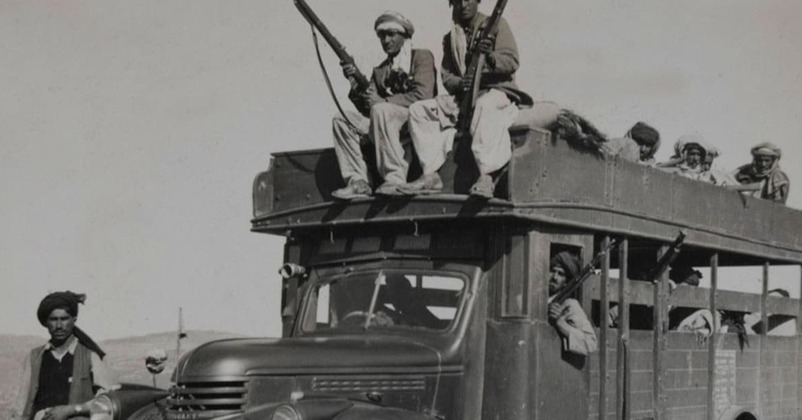
ADVANCE TOWARDS POONCH
While the relief column from Jammu succeeded in relieving the State Force garrisons at Naushahra, Jhangar and Kotli, the column from
Uri reinforced the Poonch garrison. By 20 November, the State Force garrison at Naushahra had been relieved and the position in Uri had been consolidated. Operations for the relief of Poonch from Uri could therefore be taken in hand. At 1000 hours on 20 November, Commander 161 Infantry Brigade received orders from Headquarters Jammu & Kashmir Division to send a force for the relief of the Poonch garrison.
The force comprised:
1) Kumaon (Para Battalion)
2) Dogra less two companies
Two troops 7 Light Cavalry
17 Mountain Battery
1 Sikh and a troop of 32 Field Battery were left behind for the defence of the firm base at Uri. The plan was for 1 (Para) Kumaon with supporting arms to be established at Poonch and for the rest of the force to return to Uri. The road to Punch was narrow and there were numerous hair-pin bends. There were many small wooden bridges. The time of departure from Uri was 1130 hours on 20 November but much delay was caused due to a temporary and difficult diversion round a demolished bridge within 3 km of the starting point.
1 (Para) Kumaon, the forward battalion, did not leave Uri till 1400 hours. The column had nearly 200 vehicles of all types and sizes, which had to negotiate the diversion. This crossing took much longer than was expected, with the result that a portion of the vehicle column had to halt for the night at milestone 7, away from the main force which halted for the night near Aliabad Sarai, about 32 km from Poonch. This vehicle column had only a small infantry escort with it, with a troop of armoured cars towards its tail end. This splitting up of the vehicle column from the main force proved a mistake, for it provided an opportunity to the enemy to halt the column by road- blocks and to launch an attack on it.
21 November proved to be the crucial day of the operations. The main force advanced from near Aliabad Sarai at 0700 hours and arrived Kahuta, to find totheir consternation that the bridge had been set on fire and completely destroyed.
The State force picquet there had itself destroyed the bridge. They had seen the lights of a large motorised column approaching, and suspected it to be the enemy. The picquet had no demolition charges, and if it had waited to definitely identify the approaching column, there was a danger of the bridge being rushed and secured by the enemy before it could be burnt down. So they immediately set fire to it.
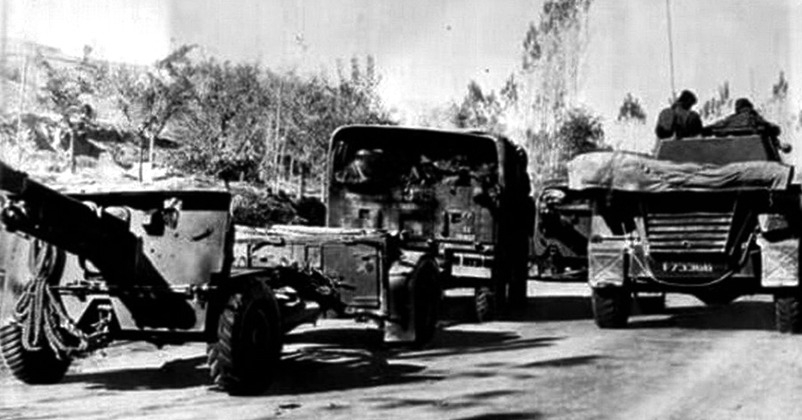
It was a terrible setback to the operation, whatever justification there may have been for the picquet's action. The main column coming to relieve Poonch had to halt at the burnt Kahuta bridge, while all hands were put to the task of making a ford.
While the main column was prevented by sheer bad luck from arriving at Poonch, the vehicle column, which had got separated from it at milestone 7, was in sore straits. All had gone well with the vehicle Column during the night 20/21 November, but it had hardly resumed the aavance in the morning on 21 November when it came across a road block around the first bend on the road. As the vehicles pulled up nose to tail to investigate, fire was opened on them from all directions. The enemy had obviously made full preparations for the attack on the column and was holding all the high features in the vicinity.
Attempts by the small infantry escort to capture one of the nearby features failed with heavy loss. Öwing to the bends in the road the armoured cars at the tail of the column could cover only a few vehicles near to them. The width of the road did not permit the armoured cars to move up the halted column. Moreover they were themselves heavily attacked. One of the armoured cars had its wheel punctured. This armoured car was turned back on the narrow road with the greatest difficulty and despatched to Uri, carrying
rmation and çasualties. After decimating the defenders, the looting party of the raiders, which had been all the while hiding in a Nala immediately below the road, sprang into action and ransacked the vehicles and set them on fire. Before last light the remaining armoured cars, fearing to be rushed in the dark, also left for Uri, carrying further casualties. That night the enemy succeeded in burning a wooden bridge at milestone 5 on the road towards the Uri side of the column. Indian casualties in this ambush were 16 killed and 14 wounded, and 24 vehicles were damaged or destroyed.
When the news of the vehicle column having been ambushed was received by Brigadier Sen, he ordered 1 (Para) Kumaon less one company under command Lieut-Colonel Pritam Singh to cross over and join the Punch garrison, while he rushed back with the rest of the force at 2300 hours on 21 November. The convoy proceeded very slowly due to numerous hair-pin bends. The column arrived at the top of the Haji Pir Pass and harboured there for the night. The advance was resumed in the morning on 23 November and the column arrived at the scene of the disaster at about 1000 hours, almost simultaneously with the arrival of a relief column from Srinagar.
The information about the ambush of the vehicles did not reach Srinagar until about 2200 hours on 21 November, when orders were received by Srinagar garrison from Headquarters Jammu & Kashmir Division to despatch troops as a relief force. 4 Kumaon less two companies were detailed for this task, and they left Srinagar by mechanical transport at 0330 hours on 22 November for Uri and thence to the Poonch road in order to establish picquet and help the sappers in making a diversion. The Dogra Pioneer Platoon commenced work straightaway to make a diversion at the site of the burnt bridge at milestone 5. They worked throughout the night to make a diversion. It was, however, a big task and could not be accomplished in so short aa time. Next day the Engineer detachment at Uri was called to help. At the end of the day it was realised that progress was not very rapid and that it would take a good part of the next day to complete the diversion.
The diversion was ready by about 1400 hours on 25 November and the convoy started moving across the river. Some of the lighter vehicles were able to go across easily, but the heavier ones had to be winched across. The whole convoy crossed the diversion by 2100 hours. Of the twenty four vehicles ambushed by the enemy, about thirteen were recovered, three cannibalized, and eight thrown overboard as total loss. The only enemy activity during the three days that the convoy was halted at the burnt bridge at milestone 5 was some sniping just a vehicles began to cross the diversion. One vehicle had a petrol tank pierced. The convoy arrived back at Uri at 0230 hours on 26 November.
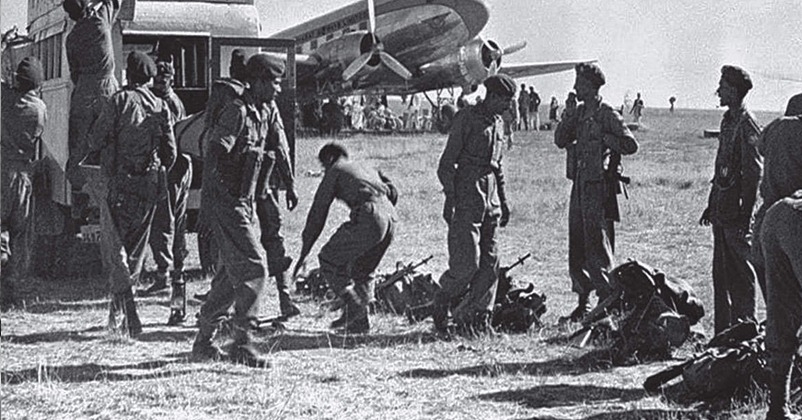
ATTACK ON THE URI PICQUET
While the Poonch column was meeting with these mishaps, 1 Sikh at Uri had to fight hard to repel a severe attack of the hostiles. Taking advantage of the preoccupation of a large proportion of the Indian forces in the area of the ambush, about 900 enemy launched an all-out attack on a small isolated picquet of 1 Sikh across the Jhelum at Uri during night 22/23 November. The attack was well timed and the objective for this attack was admirably selected. The picquet was held by only twenty men under a Junior Commissioned Officer; it was situated on a feature, which was absolutely vital for the defence of Uri; it was separated from the rest of Uri garrison by the Jhelum river, the bridge having been previously destroyed and there being only a single plank crossing prepared by the Indian troops; it would take at least two hours for reinforcements to reach its position, even if they were readily available, and provided they took the very great risk of crossing the river at night over the plank crossing.
The first attack on the picquet started at about 2300 hours, supported by very heavy medium machine gun and mortar fire from close range. The attack was repulsed. An hour later another assault was launched with even greater strength, from three directions, in an attempt to overwhelm the picquet position. The gallant garrison of the picquet, however, fought back courageously and held up the first wave of the assault within 27 metres of its perimeter. Wave after wave of the enemy attempted to capture the picquet, but to no avail. The field guns, down at Uri, which had only just arrived and had not had the chance of previously registering the defensive fire tasks, responded to the call for support by the picquet commander and materially helped the picquet to keep the enemy at bay, firing from open sights assisted by the slight moonlight of a waning moon.
Down at Battalion Headquarters, the Battalion Commander's predicament was indeed great. He realised the desperate position of the picquet, yet with every available man already committed to the defence of Uri, he had no reinforcements to send. The esprit de corps and camaraderie in the battalion may, however, be well judged from the t that the Quarter Master, Captain Joginder Singh, and his Administra- tive platoon (mostly cooks and sweepers) volunteered to go to the assistance of the picquet and after a most hazardous crossing of the Jhelum over the planks, in the middle of the night, rushed up the hill shouting war cries. The dogged resistance offered by the small garrison of the picquet and the dashing speed of this reinforcing platoon so demoralised the enemy that he abandoned any further attempt to capture the picquet and withdrew in haste, leaving behind a 3-inch mortar. It was a most gallant fight put up by a handful of Sikhs against overwhelming odds. The loss of this picquet position would have, without any doubt, jeopardised the defence of Uri, with disastrous consequences to the whole operation.
AIR SUPPORT
Royal Indian Air Force detachments at Srinagar and Amritsar supported the operations. Ten sorties (6 Spitfires, 1 Harvard and 3 Tempests) were flown on 14 November. Kotli, Mirpur and the area around these places were the main targets. Reconnaissance over Naushahra was also carried out. Kotli area was attacked four times. Two 250-lb bombs, six rockets and more than a thousand rounds of 20 mm ammunition were used to good effect.
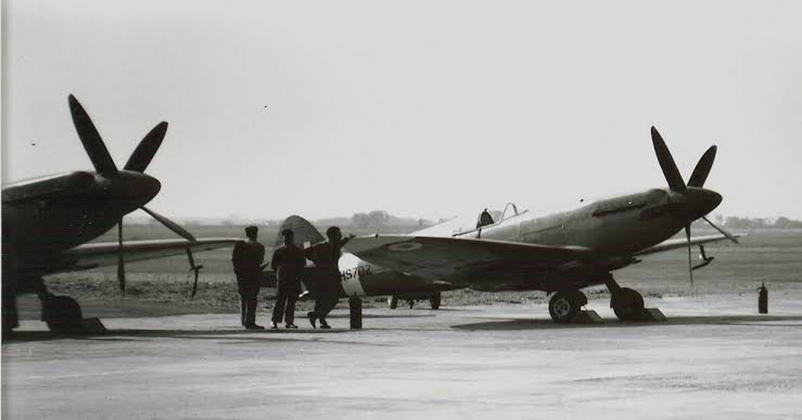
On 15 November Spitfires from Srinagar and Tempests from Amritsar carried out reconnaissance of the Uri-Domel road and attacked enemy positions in Punch-Mirpur area. Enemy positions weree also attacked in Mirpur and Kotli areas. An enemy concentration, about forty strong, was attacked successfully in the vicinity of Tithwal, approximately 24 km east of Muzaffarabad. One Dakota successfully dropped supplies over Mirpur.
On 16 November four sorties (2 Spitfires and 2 Tempests) were flown by detachments at Srinagar and Amritsar. Hostile trucks and enemy positions were attacked in Punch and Mirpur area. Enemy trucks seen on the Uri-Domel road and houses believed to be occupied by the raiders were successfully attacked.
On 17 November, Spitfires and Harvards from Srinagar continued to provide air support to the troops west of Uri. One Spitfire escorted a Dakota on a supply dropping mission over Kotli. For facilitating the drop, the belt of enemy positions surrounding the besieged garrison was strafed to force the hostiles to take cover. Supplies were also dropped over Mirpur. In doing so, the Dakota was hit by bullets in places. The wireless operator was wounded. severa Tempests from Amritsar concentrated on targets in Poonch-Mirpur area . Enemy positions were attacked at Kotli, Mangla and Mirpur. Of these, the most successful attack was made at Kotli. Enemy troops taking cover in a hut and four haystacks north-east of the town were attacked with rockets and 20 mm cannon shells. The hut was destroyed and the haystacks were left burning. These operations considerably heartened the garrison of Kotli. A group of enemy troops in the neighbourhood of Rajauri wassuccessfully attacked by a Tempest, killing four. Poor visibility hampered operations over Naushahra.
On 18 November, Tempests from Amritsar carried out offensive reconnaissance of Punch-Mirpur area. Targets indicated by ground forces w ere attacked with good results at Kotli, Mirpur and south-east of Naushahra. One enemy hut was destroyed at Kotli and another at Mirpur. On this day aircraft of Srinagar detachment moved to the new base at Jammu and started operating from there to provide close support to isolated garrisons and columns in Poonch-Mirpur area.
On 19 November, one Harvard and one Spitfire of the Royal Indian Air Force Detachment, Srinagar, carried out offensive reconnaissance over Naushahra, Jhangar and area west of Uri.
On 20 November, two Spitfires operating from Jammu carried out offensive reconnaissance of Jhangar-Kotli area. Enemy positions indicated by the Kotli garrison w ere attacked with 20 m m shells. Essential spare parts of medium machine guns were successfully dropped over the besieged garrison of Kotli. Tempests based at Amritsar carried out six sorties of offensive reconnaissance over Kotli, Naushahra, Mangla, Mirpur and Poonch.
Enemy positions within the radius of 3 to 5 km around Kotli were attacked several times
On 21 November, three Spitfires and one Harvard carried out offensive reconnaissance over Baramula, Domel and Uri-Punch-Kotli roads and the surrounding a r e a . Enemy positions around Mirpur and Kotli were attacked.
On 22 November, three Spitfires carried out defensive reconnaissance over areas Kotli, Uri-Punch road and Mirpur. Enemy positions around Kotli were again attacked. A Dakota dropped supplies over Mirpur and Kotli, but was hit by four bullets from a light machine gun.
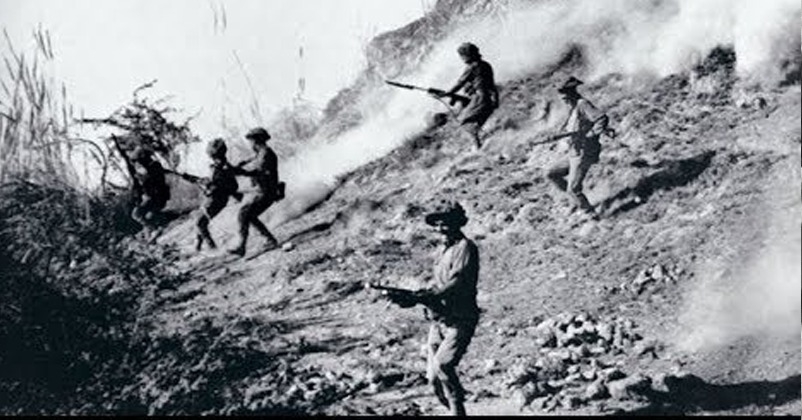
On 23 November, Spitfires and a Harvard carried out reconnaissance ofJhangar-Kotli road.An enemy position indicated by the Indian troops was attacked. Five sorties (two Harvards and three Spitfires)were flown by Royal Indian Air Force detachment at Jammu on 24 November. Offensive reconnaissance was carried out over Kotli, Bhimbar and Sadabad.
Enemy positions in the area north of Bhimbar were attacked and ten hostiles were killed. An enemy concentration in the vicinity of Sadabad was attacked effectively.
On November 25, Royal Indian Airforce aircraft carried out offensive reconnaissance over Uri-Poonch , Uri-Domel-Kohala and Jhangar-Kotli roads and also over Munawwar area. Enemy positions in the vicinity of the Ban bridge (6 to 8 km south-east of Kotli) and around Kotli were attacked. Approximately 100 enemy seen in a Nala bed, 13 km north-west of Munawwar, were attacked and six of them were killed. Targets around Mirpur were bombed; north-western part of the city was, however, found burning. Later Mirpur was found empty of troops and nearly 1200 refugees were seen moving east along Akalgarh-Naushahra road.
Eight sorties (4 Spitfires, 3 Harvards and 1 Dakota) were flown by
the detachment at Jammu on 26 November. Targets indicated by the troops in the vicinity of Kotli, Mirpur, Bhimbar and Narina were attacked. One Dakota dropped supplies successfully over Poonch.
On 27 November, two Spitfires and two Harvards from Jammu carried out offensive reconnaissance over Kotli, Poonch, Mirpur, Jammu and Domel areas. An enemy concentration, about200 strong, in a Nala near Mankriala, a village midway between Bhimbar and Munawwar, was attacked. Two enemy positions on Kotli-Punch road were also attacked. One Dakota successfully dropped supplies at Poonch.
On 28 November, Tempests and Harvards flew offensive recon- naissance over Punch, Kotli, Mirpur, Naushahra and Akhnur areas. Mirpur and its surrounding areas were the main targets. Six buses in Mirpur camp were attacked successfully. A gun-carrier with a gun approximately 180 cm long, which looked like mountain artillery, was also spotted at a point about 6 km south-west of Mirpur. The gun-carrier was attacked and destroyed. At a point approximately 8 km south-west of Mirpur a bus carrying about thirty armed men towards the south was attacked successfully with rockets. Other trucks, one of which was attacked, were also seen dispersed in the same area.
ACHIEVEMENTS OF INDIAN TROOPS
The relief operations had to be undertaken under very trying conditions. The narrow, winding, dusty road from Jammu to Beri Pattan had many hair-pin bends, which slowed down the advance. The ford at Beri Pattan had to be improved before heavy vehicles could use it. The road from Beri Pattan to Naushahra and beyond it to Jhangar had many obstacles in the shape of roadblocks. At Jhangar the road forked into two, one leading to Mirpur and thence to the Pakistan border, and the other going north to Kotli, Punch and Uri. Cut out of the side of the hills in many places and following their contours, the road was so narrow in parts that it was only suitable for one-way traffic and was intersected by innumerable unbridged Nalas. Considerable effort had to be put in by Indian Army engineers and pioneers before this road could be made fit for military traffic.
In spite of these difficulties, the relief operations were carried out successfully. Naushahra, Jhangar and Kotli were relieved. Mirpur could not be succoured in time, but a party of the garrison managed to fight its way out. The relief column from Uri to Poonch was halted at the blown up bridge at Kahuta, and returned to Uri, but 1 Kumaon less one company managed to cross the river and reach Punch, thus enabling the garrison to hold out successfully until it could be relieved. The Royal Indian Air Force played an important part in harassing the enemy.
Before the end of November 1947, the Indian army and air force had successfully completed the preliminary task of rescuing from the raiders the Kashmir Valley, Jhangar, Naushahra and Kotli. These operations also revealed the real immensity of the task, which clearly involved prolonged and heavy fighting. The impromptu battles were over. Operations in the coming months required long-term, deliberate planning, which was immediately taken in hand.
(Excerpts have been taken from "History of Operations in Jammu and Kashmir 1947-48")
One machine gun platoon of 1 Mahar